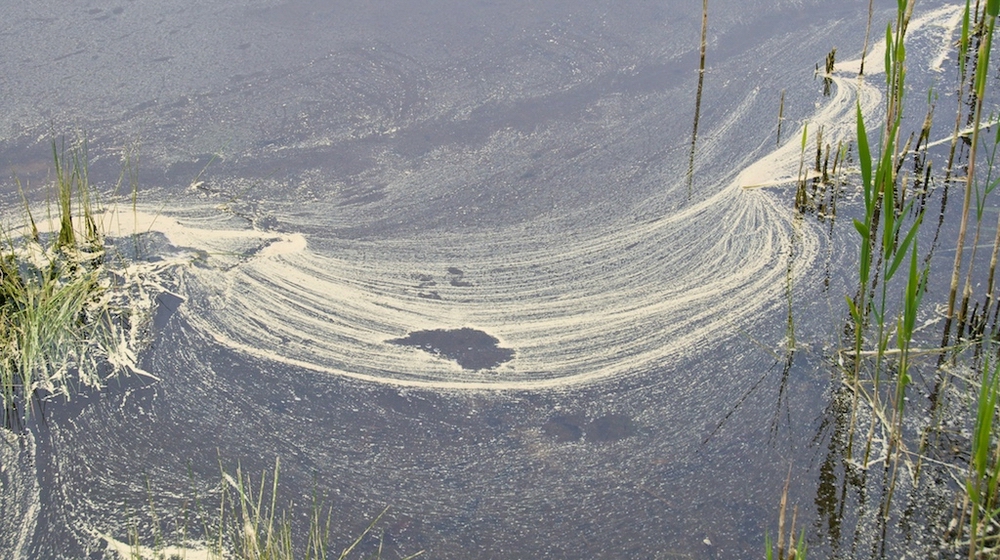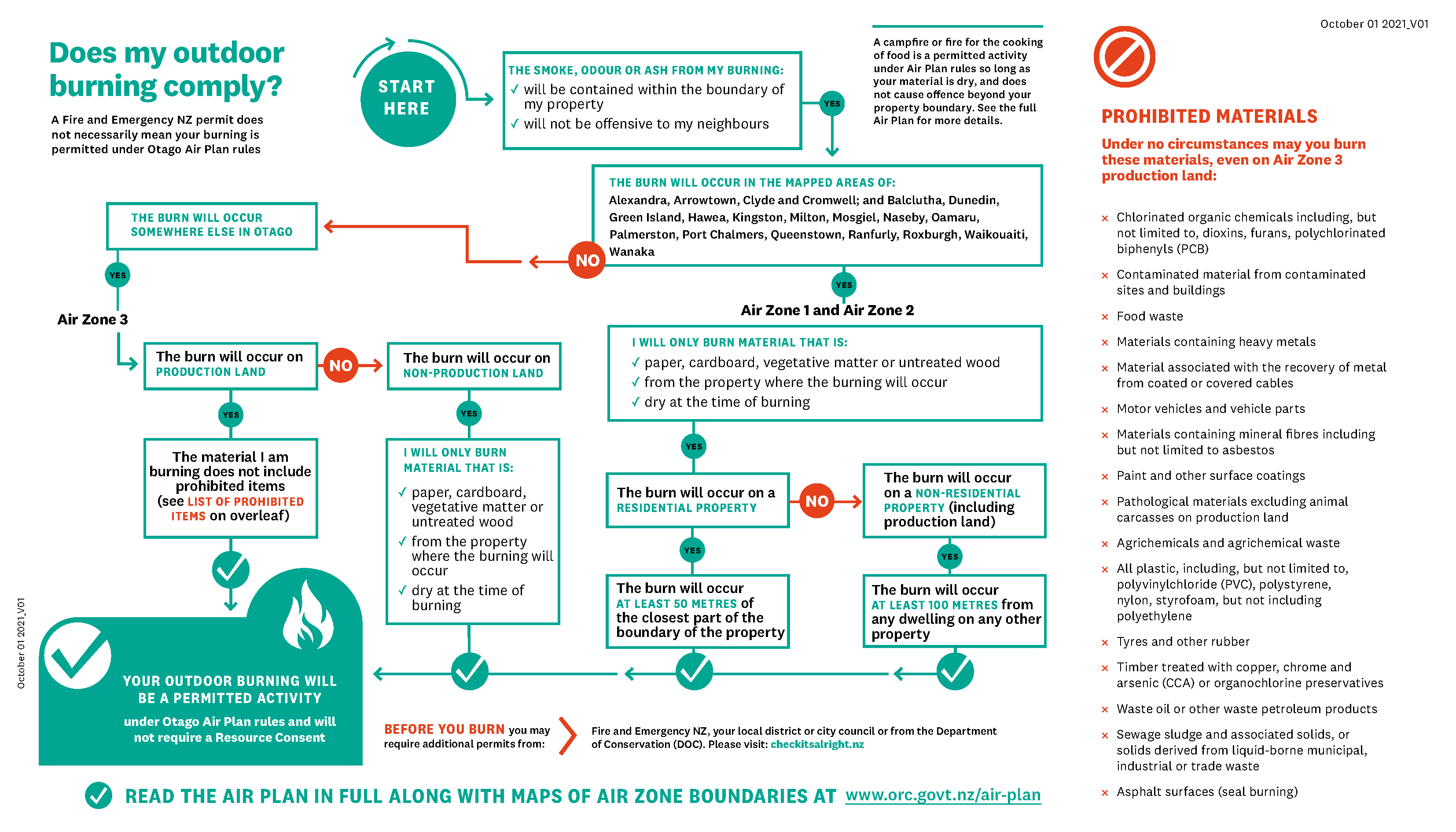Outdoor burning refers to any burning in or on the ground, or in a container outdoors. This includes the burning of organic material — like branches, leaves, or untreated wood, by rural landowners to manage vegetation.
Activities including the use of braziers, hot tubs, outdoor fireplaces, camp fires, bonfires and hangi are also considered outdoor burning.
Outdoor burning is often used by rural landowners and lifestyle block holders as part of normal land management — for example, when clearing shelterbelts, pruning trees, or removing fallen debris after a storm.
When carried out responsibly, outdoor burning can be a practical way to reduce fire hazards and manage vegetation. However, it must be done carefully to protect air quality and avoid smoke affecting neighbours or nearby towns.
You can help reduce air pollution from outdoor burning. Before you light up, make sure you’re familiar with the rules in place to protect the environment and community health — including when, where, and what you can burn.
Although the Otago Air Plan allows some outdoor burning, we encourage alternatives such as composting, mulching, using kerbside collection services or visiting a transfer station.
There are three different types of outdoor burning:
- Industrial burning
- Backyard fire
- Vegetation/forestry burn off
Any outdoor fire – including a brazier, a controlled rural burn-off, or a hangi – must comply with Otago Air Plan rules.
Learn what is and isn’t allowed
Having a permit from Fire and Emergency New Zealand (FENZ) does not necessarily mean your burning is permitted under Otago Air Plan rules.
Fire and Emergency New Zealand sets fire seasons, tracks daily fire danger, and issues permits to burn.
Their rules depend on what kind of fire you have and whether it's an open, restricted or prohibited season. Before you light a fire, check your plan at checkitsalright.nz and get a permit if you need one. You must also follow the Otago Air Plan rules for what you can burn and where the fire is.
The answer depends on what you want to burn, how big your property is and where you live. FENZ may also have restrictions on outdoor burning. In all cases, the most stringent regulation applies.
Ok to burn
- Untreated wood
- Paper
- Cardboard
- Vegetation (must not be green unless in Air Zone 3)
Not ok to burn
- Rubber, including tyres, tubes and foam rubber
- Painted or treated wood
- Waste oil and waste petroleum products
- Plastics of any kind, including vinyl, nylon, and polystyrene (you can burn polyethylene — used for bale wrap)
- Asbestos
- Metals and coated wires or cables
- Food waste
- Disposable nappies
- Chemicals including garden sprays and agrichemicals
- Paints, varnishes or other surface coatings
- Motor vehicles or vehicle parts
- Any pathological material (including but not limited to offal, body parts, or medical waste of any kind). This excludes animal carcasses on production land.
- Sewage sludge, such as solids from septic tanks
- Material from contaminated sites or buildings
- Printed circuit boards (PCBs)
- Asphalt surfaces
If you meet the Air Plan conditions for having a fire, you should reduce smoke and burn safely and considerately.
- Burn as far from your property boundary as possible.
- Check that the wind is predicted to be away from built-up areas for the duration of the fire.
- Postpone the lighting of your fire if there's already smoke from other fires in the air.
- Make smaller fires.
- Use dry fuel and stack it loosely.
- Don't let the fire smoulder.
- Avoid burning in the early morning or late afternoon/evening (breezier daytime conditions help to disperse the smoke).
- Avoid burning when there is an inversion layer.
- Be prepared to put the fire out if conditions change or you discover that you are causing a nuisance.
- Ensure burning on the property is permitted under the Air Plan.
We've produced a quick guide for anyone who wants to know if their outdoor burn is permitted.
Composting
Composting is a simple and effective way to reduce much of your garden waste. Information is available from ORC and your city or district council.
Shredding or chipping prunings
Shredded prunings are good as garden mulch. There are garden and property maintenance businesses that will shred your prunings for you or you can hire or buy a machine to do this.
Recycling
Recycle your newspapers, magazines, junk mail and cardboard. Use any kerbside collection for recycling provided by your city or district council. This should take care of glass bottles and jars, aluminium cans,steel cans and plastic bottles. You can also recycle almost anything at your official landfill.
An air zone is an area or group of areas where particular rules apply under the Otago Regional Council’s Air Plan. The rules for an air zone set out where certain activities, like outdoor burning, can take place. Air zone rules consider factors such as population density, land use, and the likelihood of smoke affecting nearby communities. For example, urban areas tend to have more restrictive rules to protect people’s health, while rural or production land may have fewer restrictions.
Learn what air zone you are in and what you can and can’t burn in these areas with the interactive map below:
Outdoor burning is burning outside. It can be in or on the ground, or in a container. It includes burning in a heap, burning in a drum, burning of standing vegetation, campfires, barbecues, bonfires, hangi, umus, and braziers or other solid fuel patio heaters and appliances.
Smoke from burning gets up your nose, in your eyes and in your clothes. It can be very toxic or just a nuisance to neighbours. We get many complaints about air pollution, particularly in urban areas.
Regulations control outdoor burning throughout Otago. But the regulations are toughest in Air Zones 1 and 2 where we see the worst air quality. You can see the air zones in our Air Plan: Air for Otago.
Dirty burning produces dark grey, black or brown smoke. You can report dirty burning to the ORC Pollution Hotline 0800 800 033. White smoke generally indicates responsible burning.
We recommend you check whether your outdoor burning requires a permit from your local district or city council, Fire and Emergency NZ and in some cases, the Department of Conservation.
You must also comply with the ORC Air Plan rules.
You can only do this if the fire is at least 50 metres from any boundary, you are only burning permitted items listed above, and the smoke is not a nuisance to your neighbours. In Air Zones 1 and 2, it is highly unlikely that your property will be big enough to meet the requirements.
You need a resource consent for a fire less than 50 metres from any boundary.
You can burn paper, cardboard, plant matter and untreated wood. The material must be dry. You cannot burn green plant material just cut from living plants. Wood must not be painted, varnished or treated, or contain glues or other plastics.
The fire must be at least 50 metres from any boundary and the smoke must not be a nuisance to your neighbours. In Air Zones 1 or 2, it is highly unlikely that your property will be big enough to meet the requirements.
You can only burn dry paper and cardboard, or dried plant material. Check the list of materials you can't burn above.
The fire must be 50 metres from any boundary and the smoke must not be a nuisance to your neighbours. In Air Zones 1 and 2, it is highly unlikely that your property will be big enough to meet the requirements.
Yes – providing it is at least 50 metres from all your boundaries. The smoke must not be a nuisance to the neighbours at the boundary. In Air Zones 1 and 2, it is highly unlikely that your property will be big enough for this.
Yes – providing the smoke, ash and smell do not cause a nuisance to your neighbours at or beyond the boundary.
Yes – providing the smoke, odour, ash, etc do not cause a nuisance to your neighbours at or beyond the boundary of your property. Talk to your neighbours and check your city or district council's requirements for celebratory bonfires.
The rules are the same as for households, but your fire must be at least 100 metres from the nearest dwelling on another property.
You can burn outdoors so long as the material is dry – paper, cardboard, plant matter or untreated wood. The plant material must not be green, so not just cut from living plants. Wood must not be painted, varnished or treated, or contain glues or other plastics.
The fire must not cause a nuisance to your neighbours or anyone else beyond your property boundary, including road users.
We recommend you dispose of most rubbish another way.

Air plans and policies
The Regional Plan: Air for Otago (the Air Plan) assists us in managing Otago's air resource.

Air quality and health
Exposure to air pollution has multiple negative impacts on health and is well-researched globally. In Otago, our biggest problem is particulate matter, PM10 and PM2.5

Air quality science
Air quality science monitors the tiny particles in our air that can harm health, particularly in vulnerable groups. Weather influences their dispersion, often peaking during cold, calm conditions.

Dust
Dust can come from natural sources (like soil) and human-made sources (like industrial factories).

Home heating
Home fires are a significant source of air pollution in some Otago towns. Get tips on reducing air pollution, heating your home economically, and the fireplace rules & regulations in Otago right here.

Odours
If unpleasant smells bother you, let ORC know. Industry, farming, and treatment facilities can cause disruptions. ORC helps with effective odour management.

Report air pollution
If you observe any type of air pollution in Otago, such as dust, odours, or other pollutants, please contact our Pollution Hotline at 0800 800 033 or fill in the form on our Report Pollution page. Your information is crucial in helping us maintain a cleaner environment for everyone in Otago.

Reports and publications - air
The health of people in Otago depends on clean air. ORC is responsible for managing and reporting on Otago’s ambient (outdoor) air quality and carrying out long-term continuous monitoring. We share several reports that look at the air quality in our region.

